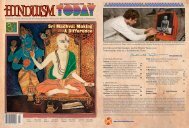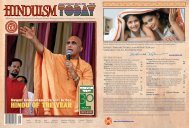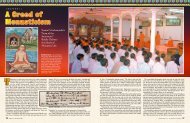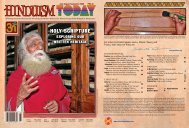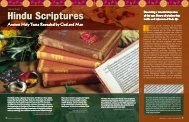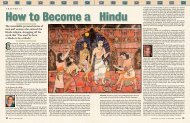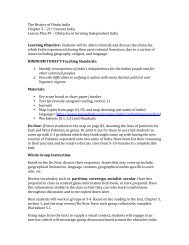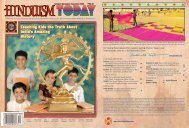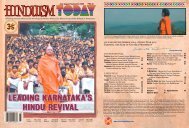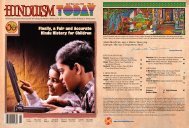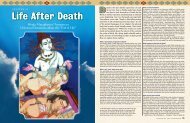Hinduism Today July 2007 - Cover, Index, Gatefold, Front Articles
Hinduism Today July 2007 - Cover, Index, Gatefold, Front Articles
Hinduism Today July 2007 - Cover, Index, Gatefold, Front Articles
Create successful ePaper yourself
Turn your PDF publications into a flip-book with our unique Google optimized e-Paper software.
What Is Liberation?<br />
H<br />
aving lived many lives, each soul eventually seeks release from mortality, experiences<br />
the Divine directly through Self Realization and ultimately attains liberation<br />
from the round of births and deaths. All Hindus know this to be their<br />
eventual goal, but the means of attainment and understanding of the ultimate state vary<br />
greatly. The point in evolution at which the individual earns release and exactly what<br />
happens afterwards is described differently in each of the Hindu denominations. Within<br />
each sect there are also distinct schools of thought. These are the subtle, profound and<br />
compelling perspectives we explore below.<br />
Bliss: Left, in a mountain cave, a worshiper of God as<br />
the Absolute Reality (Sivalinga) transcends the mind<br />
and completely realizes his oneness with all of creation.<br />
His samadhi is so deep that his outer identity dissolves,<br />
shown by the starry sky pervading his body<br />
Having realized the Self, the rishis, perfected<br />
souls, satisfied with their knowledge, passion-free,<br />
tranquil—those wise beings, having attained the<br />
Ominipresent on all sides—enter into the All itself.<br />
Atharva Veda, Mundaka Upanishad 3.2.5<br />
The dawn of freedom from the cycle of reincarnation is called<br />
moksha (liberation), and one who has attained the state of<br />
liberation is called a jivanmukta (liberated soul). While some<br />
schools of <strong>Hinduism</strong> teach that liberation comes only upon death,<br />
most recognize the condition of jivanmukti, a state of liberation<br />
in which the spiritually advanced being continues to unfold its inherent<br />
perfection while in the embodied state. It is said of such<br />
a great one that “he died before he died,” indicating the totally<br />
real, not merely symbolic, demise of the ego, or limited self-sense.<br />
Some schools hold the view that liberated beings may voluntarily<br />
return to the physical universe in order to help those who are as<br />
yet unliberated.<br />
The Sanskrit word moksha derives from the root muk, which<br />
has many connotations: to loosen, to free, release, let loose, let go<br />
and thus also to spare, to let live, to allow to depart, to dispatch, to<br />
dismiss and even to relax, to spend, bestow, give away and to open.<br />
Philosophically, moksha means “release from worldly existence or<br />
transmigration; final or eternal emancipation.” But moksha is not<br />
a state of extinction of the conscious being. Nor is it mere unconsciousness.<br />
Rather it is perfect freedom, an indescribable state of<br />
nondifferentiation, a proximity to, or a oneness with, the Divine.<br />
Moksha marks an end to the earthly sojourn, but it may also be<br />
understood as a beginning, not unlike graduation from university.<br />
Apavarga and kaivalya are other apt terms for this ineffable condition<br />
of perfect detachment, freedom and oneness.<br />
<strong>Hinduism</strong> is a pluralistic tradition. On any given subject it offers a<br />
variety of views that reflect different human temperaments and different<br />
levels of emotional, intellectual, moral and spiritual development.<br />
So, too, on the subject of liberation, various learned opinions<br />
exist. Since liberation involves transcending time and space, and yet<br />
is a state that can be achieved while in a body, it defies precise definition.<br />
For this reason, some have argued that different views of liberation<br />
simply reflect the built-in limitations of language and reason.<br />
Many Paths<br />
The Vedas themselves present a number of approaches to liberation.<br />
Some of these are agnostic; others involve various monistic<br />
and theistic views. The main classical text on Self Realization<br />
within the Vedanta tradition, the Brahma Sutra of Badarayana,<br />
mentions a number of then current views: that upon liberation<br />
the soul (jiva) attains nondifference from Brahman (IV.4.4); that it<br />
gains the attributes of Brahman (IV.4.5); that it exists only as pure<br />
consciousness (IV.4.6); that even though it is pure consciousness<br />
from the relative standpoint, it can still gain the attributes of Brahman<br />
(IV.4.7); that through pure will alone it can gain whatever it<br />
wishes (IV.4.8); that it transcends any body or mind (IV.4.10); that<br />
it possesses a divine body and mind (IV.4.11); and that it attains<br />
all powers except creatorship, which belongs to Ishvara<br />
alone (IV.4.17). Generally, the view that the soul<br />
attains the Absolute only is more represented by the<br />
Brihadaranyaka Upanishad, while the Chandogya<br />
Upanishad mentions liberation along with the attainment<br />
of lordly powers. Most later ideas of moksha are<br />
variations on these same Vedic views.<br />
At one end of this metaphysical spectrum are the<br />
jnanis who follow the yoga of knowledge and who ascribe<br />
to the view that the Ultimate Reality is formless<br />
and unqualified (nirguna). At the other end are the<br />
bhaktas who follow the yoga of devotion and commonly<br />
believe that the individual being (jiva) remains<br />
in communion with its beloved (Bhagavan). Thus,<br />
devotees believe that they will come to inhabit the divine<br />
realm, or loka, of their chosen Deity, Siva, Vishnu,<br />
Kali, etc. Each metaphysical view has given rise to a<br />
distinct practical approach to reaching Oneness and<br />
Liberation.<br />
Later Advaita Vedantins, such as Shankaracharya,<br />
spoke of two types of liberation. The first is complete<br />
or direct liberation, which they regarded as the highest<br />
state. The second is a gradual liberation that occurs<br />
wherein the individual being goes, after death, first to<br />
the heaven of Brahma and then gains liberation from<br />
there without having to return to the physical world.<br />
Ramana Maharshi, the great sage of South India, observed<br />
that three types of liberation are mentioned in<br />
<strong>Hinduism</strong>: without form, with form, and both with<br />
and without form. He considered true liberation as<br />
transcending all such concepts (Saddarshana 42).<br />
The Natha Saivite perspective is as follows. To attain<br />
liberation while living, the realization of the Self<br />
has to be brought through into every aspect of life,<br />
every atom of one’s body. This occurs after many experiences<br />
of nirvikalpa samadhi. Through harnessing<br />
the power of sannyasin and tapas, the adept advances his or her<br />
evolution. Only great tapasvins achieve jivanmukti, for one must<br />
be proficient in brahmacharya, yoga, pranayama and the varied<br />
sadhanas. It is a grace made possible by guidance of a living satguru<br />
and attained by single-minded and strong-willed discipline,<br />
worship, detachment and purification.<br />
Thus, it is possible to realize the Self—as in nirvikalpa samadhi—<br />
and still not reach the emancipated state. If this happens, the being<br />
reincarnates in the physical world after death and in his new body<br />
has the opportunity to build upon past virtues and realizations<br />
until finally becoming a jivanmukta in that or a future birth.<br />
a. manivel<br />
What distinguishes the mukta from the nonliberated individual<br />
is his total freedom from all selfishness and attachments, his permanent<br />
abidance in the all-pervading Divine Presence, his lucid,<br />
witnessing consciousness and his wisdom (jnana), revealed in<br />
spontaneous utterances.<br />
Even after attaining perfect liberation, a being may, after passing<br />
into the inner worlds, consciously choose to be reborn to help others<br />
on the path. Such a one is called an upadeshi—exemplified by<br />
the benevolent satguru—as distinguished from a nirvani, or silent<br />
ascetic who abides at the pinnacle of consciousness, whether in<br />
this world or the next, shunning all worldly involvement.<br />
Summary<br />
All schools are agreed that liberation is the ultimate fulfilment of<br />
human life, whose purpose is spiritual growth, not mere worldly<br />
enjoyment (bhoga). Having lived many lives and having learned<br />
many lessons, each conscious being seeks release from mortality,<br />
which then leads to glimpses of our divine origin and finally Self<br />
Realization. This consists in discovering our true nature, beyond<br />
body and mind, our identity in the incomprehensibly vast ultimate<br />
Being. Upon this discovery, we are released from the round<br />
of births and deaths and realize eternal freedom, untold bliss and<br />
supreme consciousness.<br />
Views on the Nature of Soul and God<br />
The concept of moksha for every Hindu school of thought is informed<br />
and modified by its understanding of the individual and<br />
its relationship to God. Most Hindus believe that after release from<br />
birth and death the innermost being will exist in the higher regions<br />
of the subtle worlds, where the Deities and spiritually mature beings<br />
abide. Some schools contend that the soul continues to evolve<br />
in these realms until it attains perfect union and merger with God.<br />
Others teach that the highest end is to abide eternally and separately<br />
in God’s glorious presence. Four distinct views, reflected in<br />
the primary Hindu denominations, are explored below.<br />
Smarta <strong>Hinduism</strong>: All is Brahman<br />
Smartism (the teaching following smriti, or tradition) is an ancient<br />
brahmanical tradition reformed by Adi Shankara in the ninth century.<br />
This liberal Hindu path, which revolves around the worship<br />
of six fundamental forms of the Divine, is monistic, nonsectarian,<br />
meditative and philosophical. Ishvara and the human being are<br />
in reality the singular absolute Brahman. Within maya, the soul<br />
and Ishvara appear as two. Jnana, spiritual wisdom, dispels that<br />
illusion.<br />
Most Smartas believe that moksha is achieved through jnana yoga<br />
alone. This approach is defined as an intellectual and meditative<br />
but non-kundalini yoga path. Yet, many Advaitins also recognize<br />
the kundalini as the power of consciousness. Ramana Maharshi<br />
and Swami Shivananda of Rishikesh did, and Shankara wrote on<br />
tantra and kundalini as in the Saundarya-Lahiri. Guided by a realized<br />
guru and avowed to the unreality of the world, the initiate<br />
meditates on himself as Brahman to break through the illusion of<br />
maya. The ultimate goal of Smartas is to realize oneself as Brahman,<br />
the Absolute and only Reality. For this, one must conquer<br />
the state of avidya, ignorance, which causes the world to appear<br />
as real.<br />
For the realized being, jivanmukta, all illusion has vanished,<br />
48 hinduism today july/august/september, <strong>2007</strong><br />
j u ly / au g u s t / s e p t e m b e r , 2 0 0 7 h i n d u i s m t o d ay 49



